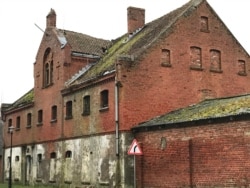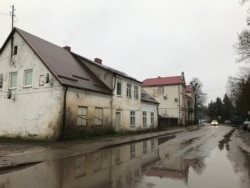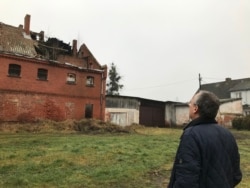ZALESYE, Russia – With a large metal key, Viktor Saltanovsky swings open the oversized wooden doors of an abandoned brick building in this village some 70 kilometers northeast of the city of Kaliningrad -- formerly Koenigsberg.
The stone staircase is dark and dusty and leads to a narrow corridor on the second floor. Through open doors, one can see small, empty rooms, each illuminated by an arched window still guarded by formidable iron bars. The doors have numbers and peepholes. A couple of ceramic stoves stand cold and crumbling in the corridor.
"Germans come and see me," Saltanovsky told RFE/RL, "who were in jail here -- for a month or two, for various things. One stole a cow or a horse, others for some other small infraction."
Saltanovsky, an entrepreneur who owns two stores in Zalesye and a guest house in a settlement outside of town, now also owns this hulking, 19th-century brick building -- the police headquarters and jail when Zalesye was the East Prussian town of Liebenfelde. He bought it late last year.
"You can imagine how my wife reacted," he laughed. "Imagine your husband coming home to you and saying, 'Honey, I bought you a ruin.'"
From the front, Saltanovsky's jail doesn't seem to be in such bad shape, if one doesn't dwell too long on the scraggly birch trees growing between the roof tiles. But walk around to the rear and the picture is more dire. Half of the roof has collapsed into the building and the façade is badly scarred.
It will take 4 million to 5 million rubles ($65,000 to $80,000) to stabilize the structure, Saltanovsky estimated.
"Obviously, everything has been destroyed, including by our generation," he said. "The windows are broken out. It is a miracle that the iron bars haven't been pulled out and taken for scrap. The roof has caved in. The building is a good one, but it needs a lot of work. My goal is to try to save at least something."
Rich Heritage
The Liebenfelde jail is probably a lucky example of the rich heritage of stone and brick architecture that the Soviet Union suddenly possessed when it annexed East Prussia after World War II and created the Kaliningrad Oblast, a Montenegro-sized region sandwiched between Poland and Lithuania on the Baltic Sea.'
When it was part of East Prussia, about 5,000 people lived in Liebenfelde. It has a large railway station, a prominent church, a bank, a courthouse, and, of course, a jail. But the tumbledown buildings and potholed streets present a different picture of this village of about 1,000.
"Once a German professor told me: 'I understand that you won the war and this is all yours. But why are you destroying it?'" Saltanovsky recalls. "And another German told me this memorable phrase: 'When I came here, it was as if someone had poked me in the eye with a stick.' It was that painful to him."
Just a bit down the street from Saltanovsky's jail there is a complex of 19th-century buildings that now belongs to the Russian Orthodox Church.
"Thirty years ago, that church was in pretty good shape," Saltanovsky said. "At the time, it would have cost about 50,000 German marks ($28,000) to restore it, and the Germans were ready to give the money. But we refused. They said we don't need [non-Russian Orthodox believers] coming around."
"So, we asked the priest what the church would do with the buildings," he concluded. "And he said, 'To tell the truth, we'll take them apart for the bricks."
That sad fate is common for such buildings, said Oleg Li, coordinator of the nongovernmental Prussian Cultural Heritage group.
"The losses have been enormous," Li told RFE/RL. "But there are still places for such people to do their work. Taking buildings apart for the bricks is done on a massive scale in the eastern and southern parts of the region, where the economy is bad. In the coastal cities, and especially Kaliningrad, they are just knocked down to make way for new construction."
Li's group says that 35 buildings, one bridge, and one underground bunker were destroyed in 2019 alone. None of them had protected status. There is no official list of such monuments.
It was estimated that about 30 percent of the region's buildings were in useable condition when the Soviet Union annexed the region in 1945.
"The war ended [long ago], but we are still losing things year after year," Li said.
Success Stories
The society has noted some important success stories, however.
Some 120 kilometers from Kaliningrad in the city of Neman, a businessman named Ivan Artyukh who describes himself as "a romantic adventurer," has taken a 20-year lease from the Russian Orthodox Church on Ragnit Castle.
He doesn't have a plan, although he's hoping to save at least some of the remaining walls.
Just outside of Kaliningrad, a couple from Belgorod named Nadezhda and Sergei Sorokin are working to restore Valdau Castle, which once hosted Napoleon.
"We all need this place," Nadezhda Sorokina told RFE/RL in an interview in April. "This castle is a living witness to 12 centuries of history. Napoleon was here."
"They need it," she added, pointing to her two sons, Savely and Pasha.
The repairs will cost millions of rubles.
"There aren't many such examples, but they do exist," Li told RFE/RL. "The Langdorf Chateau has been restored and now is beautiful and working as a resort."
"What we need is the goodwill of the state," said Viktoria Korneva, director of the Khobbi-tur tourism firm. "Individual people can't solve these problems alone. A state policy needs to be determined. Either we want to save our history, or we don't. Considering that this is the main form of tourism [in this region], it would be very stupid to lose all of this."
Viktor Saltanovsky is a perfect example of the idealist entrepreneur.
"I'm amazed at what a beautiful building it is," he said, looking up at his jail. "How well everything is built! From the beginning, this was a mad project. There wasn't even a plan, to be honest. I live in a German house and I have German roots. I wanted to leave something behind. And you have to admit, owning a jail is pretty interesting."
Now he hopes to turn the ground floor into a café and a small museum. He plans to turn the upper-floor cells into a hostel.
"I can rent rooms for 200 rubles ($3.25) a day to local agricultural workers," he said. "There aren't many places to stay in this village."
For now, he has cleared the former jail exercise yard and plans to open a small store and a beer garden there.
"This building is like an adopted child or a bedridden patient," he said. "It might not be a living thing, but it wants to live just the same."














